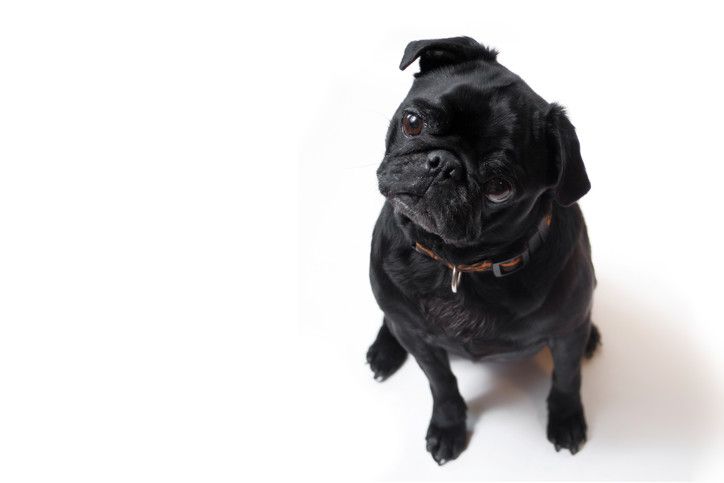Pug puppies, and to a lesser extent pug adults, are seen as one of the cutest dogs around.
This is largely due to their playful attitude, sociable temperament and facial features.
Many dog owners simply can’t resist those big black eyes.
Most pug owners are drawn to pure bred individuals with the classic build and markings and that soft fawn coat.
Black pugs, meanwhile, tend to be less popular.
This guide aims to look at the black pug in more detail to determine the reason for this trend, any key differences between black and fawn pugs that could affect your choice of pug puppy and general tips for looking after black pugs.
For the most part, you will find a lot of similarities between the two colors, but there are some genetic traits and stories from owners than can cause a slight divide.
With this black pugs information, hopefully you will be closer to deciding whether you want to stick with a fawn pup, or are happy to adopt a less popular black one.
Table of Contents
What are some key physical black pug characteristics that prospective owners should watch out for?
Physically speaking, black pugs tend to be very similar to fawn pugs in terms of their build, size facial structure etc.
They are both stocky, muscular little dogs with the same short legs, the same build, that shorted snort and those prominent black eyes.
The only major difference here is in the colour of the coat and the markings.
If you were to view a black and white photo of two pugs, the only way of telling the black from the fawn would be the darker area on the muzzle of the fawn and the stripe on the back.
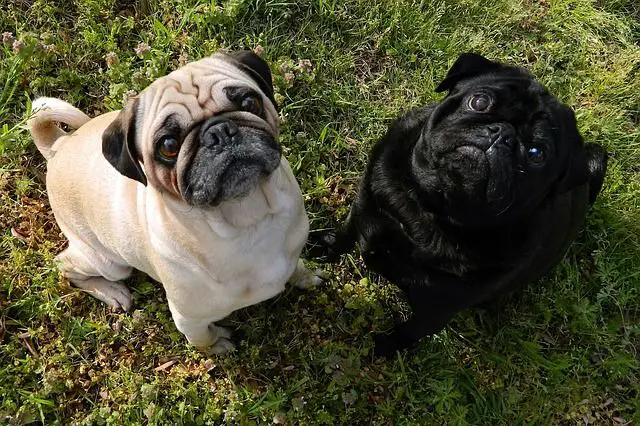 Image source: Pixabay
Image source: Pixabay
There are some black pugs that have white markings, often around the chest and paws, but most are a sleek, solid black.
If the black gene is really the most dominant, why do you see more fawn puppies?
The answer to this is all down to popularity. All black pugs tend to be less popular than their fawn cousins because they are deemed to be less attractive.
They do not share the same markings as fawn pugs, who have that black muzzle and the stripe down the back and are therefore not considered by all dog owners to be a true representation of what a pug should look like.
There is also the fact that those big black eyes are not so striking against a black coat. This may be a surprise to keen black pug owners because of the handsome uniform coat.
The all-black variety is still the second most common option that is bred. There are also brindle, apricot and silver pugs, but these colours are much rarer.
Despite this mixed opinion, completely black pugs are still eligible for showing as a pure breed pug, while some associations choose not to allow other variations of colour.
The silver pug by be considered a rare beauty by some breeders, which some comparing its coat to the look of moonlight, but these dogs cannot compete for best in breed. Of course, it all depends on the show.
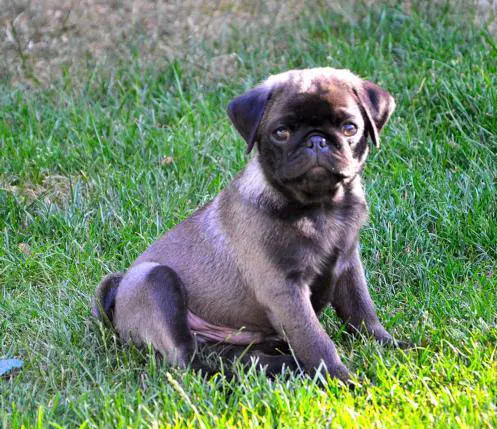 Image Source: Pinterest
Image Source: Pinterest
These rules will apply to major associations with high standards of the breed, but if you are looking to enter your black pug pup into a cutest dog categories at a local fair, most judges are sure to look at the cute features and temperament over the coat’s markings.
In the end, you will see less black pugs being sold or out in the dog park because there are simply less being bred.
The black gene is the most dominant of the two, but many breeders carefully choose their parent dogs to ensure that they get all fawn litters. These genetics do, however, mean that there is the chance of having fawn and black baby pugs in the same litter, if there is mixed parentage.
Some owners have said that they see clear differences in the behaviour of their black and fawn pups from birth. This raises an important question for new owners: are there key behavioural traits between the two forms?
Black pugs vs fawn pugs: is one better behaved than the other?
A quick look at pup owner forums will show that there are lots of pugs out there with distinct personalities; some are mischievous and highly active while others are more docile and sweet natured.
Some appear to be a momma’s boy while others will form a stronger bond with the male of the household.
There is a notion sweeping the net that it is the black pug is the most active and naughtiest of the two, but there is no scientific or genetic basis for this.
Some pug owners will be quick to agree and say that it is 100% true because their own black pup is naughtier than their fawn, but this doesn’t account for gender, age or other environmental factors that have determined that dog’s personal traits.
Others could easily find that the opposite it true.
Pug personalities can vary greatly but they all tend to be highly sociable, loving dogs with a playful attitude – this will not change if you choose to get a black pug rather than a fawn one.
The important thing to remember here is that most owners start with the phrase ‘in my opinion’. This means that you could find things are completely different.
Love your pug for who they turn out to be, don’t expect them to conform to specific traits.
Black pug training
The high spirited, active nature of the pug means that they require training to become obedient members of the pack, but the good news is that they are not that hard to train.
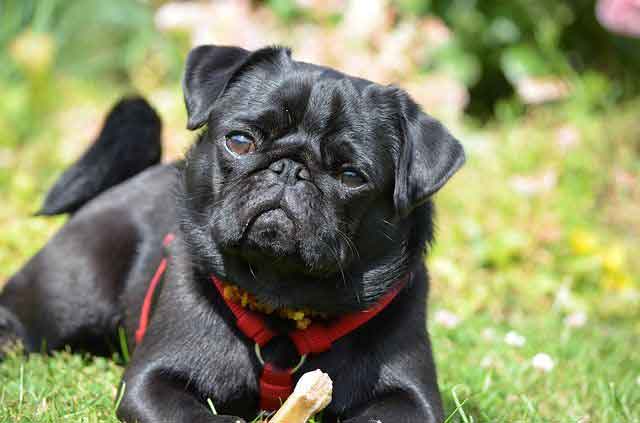 Image source: Pixabay
Image source: Pixabay
As with many dogs, it can be a lot easier to train them out of bad habits and to instil positive behaviour traits when they are young, but training adults is not impossible.
The reason for this is the fantastic combination of their need to please their owner and their desire for attention.
If any ‘chore’ is turned into a game, with love and attention, then your pug should respond pretty well.
If they perform well and you make a fuss of them, they are likely to repeat the behaviour to ensure that they keep that attention. This repetition will soon lead to learnt behaviour.
The sociable nature of black pugs also means that socialisation with other dogs and family members is not too difficult.
The most important thing to remember with any form of training is to use positive reinforcement. This breed does not respond well to negative approaches.
There is one important difference between black and fawn pugs, and that is their coat.
The behaviour traits between the two pugs may not be all that different, but there is one important difference that could affect your choice between the colors.
Black pugs have a different coat to fawn pugs and this can affect the amount of hair they shed. The pug black coat is strikingly different in that the fawn pug retains the soft undercoat and has a thicker double layer of fur to deal with, while the black pug has just the single layer.
The reason for this is unclear; at the some point that undercoat must have simply been bred out.
This doesn’t make a huge difference when it comes to the appearance of the dog, but it can have an impact on grooming and fur shedding.
There is no getting away from the fact that all pugs shed a lot, but there are many black pug owners that agree that black pugs shed less.
The simple reason for this is that there is less fur to lose and they don’t have that dense second layer pushing out the hair.
This means less time cleaning up after a black pug than a fawn pug. You would think that this might tip the scales in favour of the black variety as a household, indoor dog, but the fawn is still favoured.
The solution to the issue of pugs shedding is to adopt a strong grooming regime. This means regular brushing with simple brushes and mitts and a good bath once a month to rinse out the grime and trapped hair and improve the flow of nutrients to the coat.
enjoy being groomed.
Just like those training exercises, it is a way of gaining attention, praise and treats so they are happy to comply. They don’t even seem to mind getting wet in the bath.
As long as you keep up the regime, remember to use suitable products and are careful when drying the folds of skin, you should find that grooming is a rewarding way to deal with black pug hair loss.
Grooming may be different, but many health care needs are the same.
Because there is such little difference between the color variants on a physical level, black pug dog health care is really not all that much different to that of fawn dogs.
From puppyhood to adult life, you will find that they have many of the same needs and same potential problems to look out for.
One of the most well-publicised issues with pug is that of breathing problems. This is common due to the shorted snout and these animals can suffer from an elongated soft palette or cleft palette. This is a trait that has been breed into pugs over the centuries.
The first black pug had much longer snouts and were possibly much healthier.
Because the size of the pug the same whether it is black or fawn, it can deal with the same joint problems like hip dysplasia and knee dislocations.
They also have the same big bugling eyes and this can cause a range of additional problems.
The eyes are prone to injury and infection, because of their size and lack of brow line, and there is also the risk of entropion, which is where the eyelids end up folding inwards.
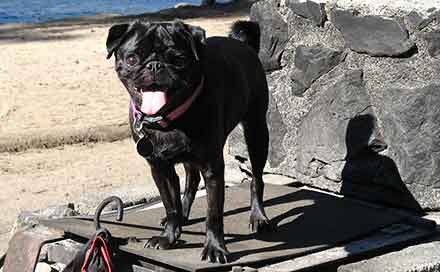 Image source: Pixabay
Image source: Pixabay
Where should you look to find black pugs for sale?
If this guide has so far convinced you that a black pug pup is the ideal addition to your family, or you are happy to look into owning a pug of any variety, the next consideration to make is where to get your pug from and at what age.
There are sure to be no shortage of adverts online, or in the local paper, for pug puppies because breeders know the appeal of these beautiful little dogs.
Some may state black pugs for sale, if they are deliberately breeding that color from black parents, or they may have a mixed litter that they are looking to sell on.
It always pays to look for a breeder with credibility, someone that has papers on the linage of the dog, information on potential health issues and a clear record of responsible practices and ownership.
A happy, healthy puppy from good stock is more likely to be a good fit, and you will know that you are giving your money to responsible, caring people.
Take your time when visiting the puppies and ask questions where you feel they are appropriate.
Watch each puppy to get a feel for clear character traits, make a fuss of them to see how they respond to you and check for any signs of poor health.
If you have your heart set on a black pug, you may find that there are only a couple to choose from.
If you decide choose based on personality, rather than color, you could make a better connection. There is a good chance that one pug will stand out from the crowd and, as this guide has shown, if a black pug grows attached to you, you are definitely not settling for second best.
What about black pug adoption?
The alternative for those that are unsure about buying from a breeder is to look into adoption.
This can be a great approach to pet ownership for two reasons: it means you can provide a home for a dog that was perhaps unwanted by a previous owner, potentially saving it from a miserable life, and it also allows you to get an adult dog.
This can be a great idea for those that don’t feel that they can raise and train a puppy, although there may be behavioural traits to deal with.
The popularity of the fawn pug means that adoption shelters may also have a wider range of pug varieties. A sweet natured black pug that wasn’t deemed cute enough by one owner could well be the ideal match for you.
With your new puppy or rescue pug adopted and brought to the family home, there is a lot to think about in terms of their training, health care and routine.
There is also the fun job of naming the dog. An adopted pug from a shelter may already have a name that they respond to that you will want to keep, but black pug puppies are in need of something that suits their character.
Lists of names for black pugs online are full of suggestions, some of which are fairly ordinary and some that are quite creative. For every Max and Jack there is a reference to mythology or popular culture.
Some focus on the small statute of their pug, with Baby being a popular choice, while others focus on their fun nature, choosing names like Buddy. Then there are all the words associated with the color black.
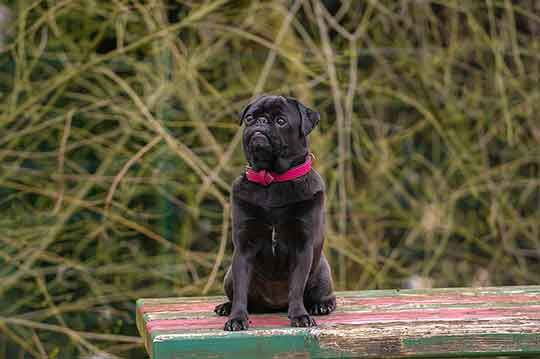 Image source: Pixabay
Image source: Pixabay
Black pug ownership can be an incredible, rewarding journey
As this guide all about black pugs has hopefully shown, there are fewer differences between black and fawn pups than you may initially expect.
The key differences here lie in the color of the coat, the prominence of key markings and the layers of hair.
A black pug does not have the same undercoat as the fawn version and is less likely to shed excessively, but many still feel that the fawn pug is the more attractive of the two.
With the looks of the dog to one side, the differences between pups in a litter are determined more by their personal traits and environment than by color.
The myth about black pug dogs being more active will persist online, but there is no guarantee that you will notice this.
Keen pug owners are sure to remain drawn to the ideal, purebred fawn that they can show and breed, even if it means a lot more grooming.
This may mean that black pugs are less desirable, but there is no real reason why they should be when they have every chance of being just as loving, playful and rewarding as a fawn.
If you love the breed for their traits and feel that color doesn’t matter, consider adopting a black pug rather than buying a fawn one. They will need the same care and attention and provide wonderful companionship.
Finally here is a cool video for a cute black pug called Molly

